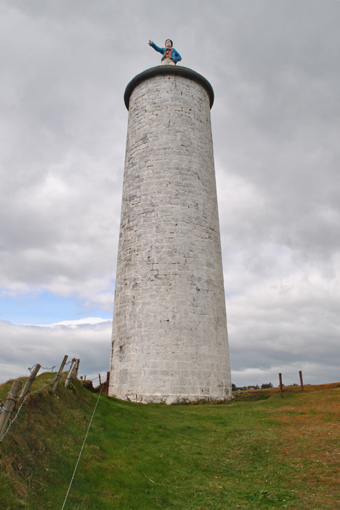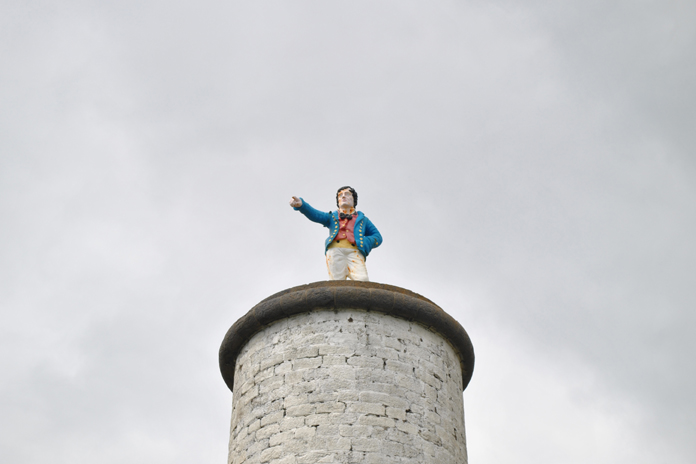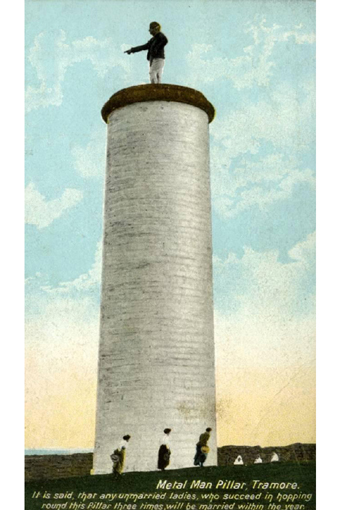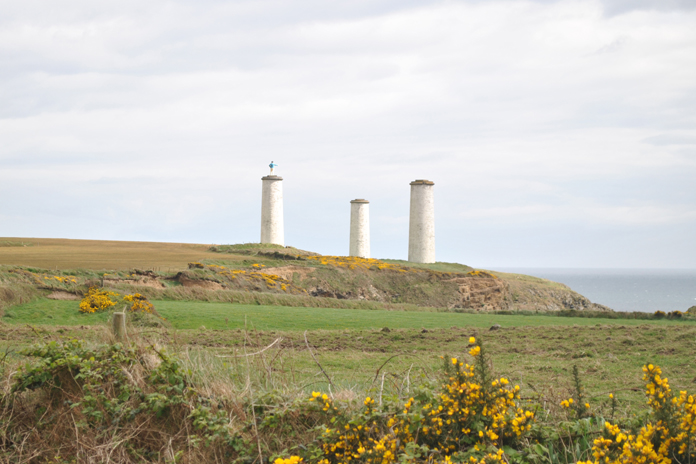Building of the Month - June 2017


A view of the three beacons erected on Great Newtown Head near Tramore, County Waterford, in response to the tragedy of the sinking of HMS Sea Horse on the 30th January 1816: two similar beacons stand on Brownstown Head and serve to distinguish Tramore Bay from the entrance into Waterford Harbour
A tragedy at sea in the early nineteenth century brought about one of the defining features of the County Waterford coastline. On the morning of the 30th January 1816 HMS Sea Horse, carrying members of the 2nd Battalion of the 59th (2nd Nottinghamshire) Regiment of Foot, hit a storm as it sailed from Ramsgate to Cork. The captain, James Gibbs, had no choice but to find the nearest point at which to drop anchor but the ship ran aground on a shoal off Tramore Bay where it foundered and was broken up within a matter of hours. Only thirty of the souls on board survived and, in addition to 292 men, 71 women and children were lost. Many of those that managed to swim the mile to shore quickly succumbed to hypothermia. HMS Sea Horse was part of a convoy of three vessels sailing that day and the two other ships, SV Boadicea and SV Lord Melville, were also wrecked with the loss of over two hundred souls.
Lloyds of London, the insurers of HMS Sea Horse, were appalled by the tragedy and, aware that the entrances to Tramore Bay and Waterford Harbour were easily confused, commissioned and funded a group of five beacons perched on top of the headlands flanking Tramore Bay. Three beacons stand on the westerly Great Newtown Head while two stand on the easterly Brownstown Head.
 |
Each of the circular-plan beacons is constructed of finely dressed stone, gently tapering to the top and finished with a beaded cap. Each beacon was given a brilliant white limewash finish designed to dazzle in sunlight, and to glow in full moonlight, warning seafarers of the potential hazards ahead. The design of the beacons has in the past been ascribed to Alexander Nimmo (1783-1832) who prepared plans for a packet ship harbour in nearby Dunmore East in 1814 and who completed a survey of the coast of Ireland in 1822 in his remit as Engineer to the Commissioners of the Irish Fisheries. However, the beacons are not included by Noël P. Wilkins in the Gazetteer of Works included in his definitive biography of Nimmo and recent research by the Commissioners of Irish Lights has identified George Halpin (1779-1854), Inspector of Works and Harbours for the Ballast Board, as a more likely design source. Indeed, the tapering silhouette of each beacon recalls a contemporary Halpin lighthouse stripped of its lantern. |

A view of the “Jack Tar” cast by John Clarke to a design exhibited by Thomas Kirk (1781-1845). Empty plinths on the adjacent towers, and on the towers at Brownstown Head, give credibility to the theory that each tower was intended to support a cast-iron figure. However, only one other “Jack Tar” is known to have been cast and today it stands on a squat podium at the entrance to Sligo Harbour
No such doubt surrounds the identity of the artist responsible for the dandy-like figure giving the central of the Great Newtown Head beacons its sobriquet “Metal Man Tower”. The Cork-born sculptor Thomas Kirk (1781-1845) could boast a healthy client base in the early nineteenth century with large-scale works including Nelson’s Pillar (1808; destroyed 1966) in Sackville Street [O’Connell Street], Dublin, and small-scale funerary monuments in churches across the country. Kirk exhibited a sketch for a “Jack Tar” at the Hibernian Society of Artists in Dublin in 1815 and a model of the same in London two years later. Two years later still a cast of the “Jack Tar” was made by John Clarke at the request of the Ballast Board. The figure, twice life size and pointing to Hook Head and the entrance to Waterford Harbour, is dressed in the uniform of British sailors at the time of the sinking of HMS Sea Horse: a gold-buttoned royal blue coat worn over a bright red waistcoat and white trousers.
|
A number of legends have grown around this curious figure overlooking Tramore Bay and it is said that during stormy weather he can be heard calling Keep out! Keep out! Good ships from me for I am the rock of misery! Early twentieth-century photographs capture a long-lost tradition where a chain of unmarried ladies would hop around the base of the tower three times in the hope of finding a husband within a year. In addition to the beacons, the sinking of HMS Sea Horse is remembered by an obelisk-topped monument in the grounds of Christ Church (Drumcannon) in Tramore; a weathered ledger on Doneraile Walk; and a “cairn” unveiled on The Promenade on the 30th January 2016, the bicentenary of the tragedy. The seahorse was also adopted as the emblem of Tramore Golf Club and Waterford Crystal. |
 |

Brendan Wright is a third year Culture and Heritage Honours Degree student studying at Wexford Campus, IT Carlow
Back to Building of the Month Archive